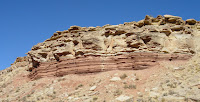 |
| Isaac Werner's penmanship |
When Isaac B. Werner kept his journal, his tool was a pen. Previous blogs have shared Isaac's effort to improve his penmenship, having a "good hand" an important indication of an educated man.
Typewriters had been invented by the 1880s and 1890s when Isaac was keeping the journal about his years on the Kansas prairie. The picture of an 1881 Hammond typewriter below was taken from the Editor's Page of Elle Decor. Michael Boodro, editor, titled his editorial "When Does An Object of Desire Become Obsolete?" His question inspired this blog.
I took a typewriting class in high school, perhaps my sophomore year, and as I recall, everyone in my class took typing, both boys and girls. I believe that was when I asked my parents for a typewriter, and I think my portable typewriter was a birthday gift. It served me through high school, college, and law school and was my only personal typewriter until the computer age arrived. I did use electric typewriters for a couple of jobs, and I remember the clatter of keys and the ding of the bell as it reached the end of each row of typing.
 |
| 1881 Hammond typewriter |
In his article for Elle Decor, Michael Boodro recalled that he asked for a typewriter for Christmas when he was twelve, adding that he was an unashamed nerd. In his editorial he used the evolution of typewriters to explore the impact of technology on the way we live. However, he also pointed out that even those things which retain their function are often abandoned for reasons of style. In other words, we often trade a perfectly serviceable automobile for a new model, or we discard clothing and furniture strictly because the styles change.
 |
| Mother's Underwood |
The Underwood typewriter of unknown vintage pictured at left once belonged to my mother. She used it to type her articles for the local newspaper, and although the sticker on the back of the machine states ownership of the copyright in Underwood Elliott Fisher Co. and production in the USA, it does not include a copyright date. Mother loved writing, and becoming a news reporter in her senior years was like a dream come true. I don't know where or when she acquired the Underwood typewriter, but it has a sticker from a Hutchinson business on the front, and I suspect she bought it when she became a reporter.
Although its date is uncertain, it seems older than the 1970s or early 1980s when Mother first became a reporter. Unlike Michael Boodro, Mother would not have rejected it because it wasn't a new model. Rather, it might have suited her imagination of what a 'girl reporter' would have used when she first dreamed of being one.
 |
| Nostalgic Mug |
When Isaac Werner ordered a book on Spenserian penmanship, would he ever have imagined that slightly more than a century later students would no longer be taught cursive writing? Will handwriting, even block printing, disappear except for jotting down brief notes as we communicate more and more by e-mail, text, tweets, and who knows what?
The advertisement for the mug pictured at right reads: "The Lost Art of Penmanship Mug," and continues, "Kids today may not be taught cursive, but some of us fondly remember learning to mind our p's and q's... Now you can enjoy the nostalgia of pretty penmanship with this 'educational' 12-ounce mug decorated with lower- and upper-case letters." I believe the generally accepted origin of the saying about p's and q's relates to pub owners calling out to patrons to mind their pints and quarts in case they needed a refill before the legal hour prohibiting serving liquor arrived. Will cursive penmanship soon be as obscure as the origin of that saying?
The advertisement for the mug pictured at right reads: "The Lost Art of Penmanship Mug," and continues, "Kids today may not be taught cursive, but some of us fondly remember learning to mind our p's and q's... Now you can enjoy the nostalgia of pretty penmanship with this 'educational' 12-ounce mug decorated with lower- and upper-case letters." I believe the generally accepted origin of the saying about p's and q's relates to pub owners calling out to patrons to mind their pints and quarts in case they needed a refill before the legal hour prohibiting serving liquor arrived. Will cursive penmanship soon be as obscure as the origin of that saying?
Many, including me, have argued that cursive writing deserves to be taught, not only for aesthetic reasons but also because taking the pains to write legibly--even beautifully--encourages thoughtful reflection, something often lost in the hasty pounding of a keyboard, abbreviated texting, and scribbled printing. The essay in Elle Decor was directed toward the impact of technology on furnishing our homes, but perhaps Boodro's ideas should also cause us to reflect on the impact of technology on communication and reason, as well as beauty.














